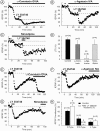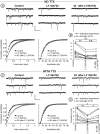Role of p/q-Ca2+ channels in metabotropic glutamate receptor 2/3-dependent presynaptic long-term depression at nucleus accumbens synapses
- PMID: 12040040
- PMCID: PMC6758789
- DOI: 10.1523/JNEUROSCI.22-11-04346.2002
Role of p/q-Ca2+ channels in metabotropic glutamate receptor 2/3-dependent presynaptic long-term depression at nucleus accumbens synapses
Abstract
The nucleus accumbens (NAc) is an important cerebral area involved in reward and spatial memory (Pennartz et al., 1994), but little is known about synaptic plasticity in this region. Here, electron microscopy revealed that, in the NAc, metabotropic glutamate receptors 2/3 (mGlu2/3) immunostaining was essentially associated with axonal terminals and glial processes, whereas postsynaptic dendrites and neuronal cell bodies were unstained. Electrophysiological techniques in the NAc slice preparation demonstrated that activation of mGlu2/3 with synaptically released glutamate or specific exogenous agonist, such as LY354740 (200 nm, 10 min), induced long-term depression of excitatory synaptic transmission (mGlu2/3-LTD). Tetanic-LTD and pharmacological mGlu2/3-LTD occluded each other, suggesting common mechanisms. The mGlu2/3-LTD did not require synaptic activity but depended on the cAMP-protein kinase A cascade. Selective inhibition of P/Q-type Ca(2+) channels with omega-agatoxin-IVA occluded the expression of mGlu2/3-LTD, and, conversely, the inhibitory effects of omega-agatoxin-IVA were abolished during mGlu2/3-LTD. Thus, mGlu2/3 play an important role in the control of use-dependent synaptic plasticity at prelimbic cortex-NAc synapses: their activation causes a form of LTD mediated by the long-lasting reduction of P/Q-type Ca(2+)channels contribution to transmitter release.
Figures






Similar articles
-
Group 2 metabotropic glutamate receptors induced long term depression in mouse striatal slices.Neurosci Lett. 2001 Dec 28;316(3):178-82. doi: 10.1016/s0304-3940(01)02397-7. Neurosci Lett. 2001. PMID: 11744231
-
Metabotropic glutamate receptor 2/3-dependent long-term depression in the nucleus accumbens is blocked in morphine withdrawn mice.Eur J Neurosci. 2002 Dec;16(11):2231-5. doi: 10.1046/j.1460-9568.2002.02273.x. Eur J Neurosci. 2002. PMID: 12473091
-
Distinct properties of presynaptic group II and III metabotropic glutamate receptor-mediated inhibition of perforant pathway-CA1 EPSCs.Eur J Neurosci. 2004 May;19(10):2847-58. doi: 10.1111/j.1460-9568.2004.03378.x. Eur J Neurosci. 2004. PMID: 15147318
-
Role of presynaptic metabotropic glutamate receptors in the induction of long-term synaptic plasticity of vesicular release.Neuropharmacology. 2013 Mar;66:31-9. doi: 10.1016/j.neuropharm.2012.05.004. Epub 2012 May 22. Neuropharmacology. 2013. PMID: 22626985 Free PMC article. Review.
-
Mechanisms of synaptic depression triggered by metabotropic glutamate receptors.Cell Mol Life Sci. 2008 Sep;65(18):2913-23. doi: 10.1007/s00018-008-8263-3. Cell Mol Life Sci. 2008. PMID: 18712277 Free PMC article. Review.
Cited by
-
Presynaptic LTP and LTD of excitatory and inhibitory synapses.Cold Spring Harb Perspect Biol. 2012 Feb 1;4(2):a005728. doi: 10.1101/cshperspect.a005728. Cold Spring Harb Perspect Biol. 2012. PMID: 22147943 Free PMC article. Review.
-
The origin of glutamatergic synaptic inputs controls synaptic plasticity and its modulation by alcohol in mice nucleus accumbens.Front Synaptic Neurosci. 2015 Jul 20;7:12. doi: 10.3389/fnsyn.2015.00012. eCollection 2015. Front Synaptic Neurosci. 2015. PMID: 26257641 Free PMC article.
-
Ca2+-dependent mechanisms of presynaptic control at central synapses.Neuroscientist. 2006 Aug;12(4):317-26. doi: 10.1177/1073858405284672. Neuroscientist. 2006. PMID: 16840708 Free PMC article. Review.
-
Presynaptic long-term depression mediated by Gi/o-coupled receptors.Trends Neurosci. 2014 Nov;37(11):663-73. doi: 10.1016/j.tins.2014.07.010. Epub 2014 Aug 24. Trends Neurosci. 2014. PMID: 25160683 Free PMC article. Review.
-
mGlu2 mechanism-based interventions to treat alcohol relapse.Front Pharmacol. 2022 Sep 15;13:985954. doi: 10.3389/fphar.2022.985954. eCollection 2022. Front Pharmacol. 2022. PMID: 36188569 Free PMC article.
References
-
- Anwyl R. Metabotropic glutamate receptors: electrophysiological properties and role in plasticity. Brain Res Brain Res Rev. 1999;29:83–120. - PubMed
-
- Brandon EP, Zhuo M, Huang YY, Qi M, Gerhold KA, Burton KA, Kandel ER, McKnight GS, Idzerda RL. Hippocampal long-term depression and depotentiation are defective in mice carrying a targeted disruption of the gene encoding the RI beta subunit of cAMP-dependent protein kinase. Proc Natl Acad Sci USA. 1995;92:8851–8855. - PMC - PubMed
-
- Cartmell J, Schoepp DD. Regulation of neurotransmitter release by metabotropic glutamate receptors. J Neurochem. 2000;75:889–907. - PubMed
-
- Cartmell J, Monn JA, Schoepp DD. The metabotropic glutamate 2/3 receptor agonists LY354740 and LY379268 selectively attenuate phencyclidine versus d-amphetamine motor behaviors in rats. J Pharmacol Exp Ther. 1999;291:161–170. - PubMed
Publication types
MeSH terms
Substances
LinkOut - more resources
Full Text Sources
Other Literature Sources
Miscellaneous
